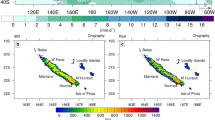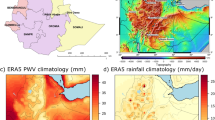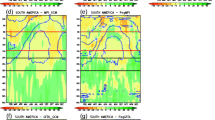Abstract
We present results from 20-year “high-resolution” regional climate model simulations of precipitation change for the sub-tropical island of Puerto Rico. The Japanese Meteorological Agency Non-Hydrostatic Model (NHM) operating at a 2-km grid resolution is nested inside the Regional Spectral Model (RSM) at 10-km grid resolution, which in turn is forced at the lateral boundaries by the Community Climate System Model (CCSM4). At this resolution, the climate change experiment allows for deep convection in model integrations, which is an important consideration for sub-tropical regions in general, and on islands with steep precipitation gradients in particular that strongly influence local ecological processes and the provision of ecosystem services. Projected precipitation change for this region of the Caribbean is simulated for the mid-twenty-first century (2041–2060) under the RCP8.5 climate-forcing scenario relative to the late twentieth century (1986–2005). The results show that by the mid-twenty-first century, there is an overall rainfall reduction over the island for all seasons compared to the recent climate but with diminished mid-summer drought (MSD) in the northwestern parts of the island. Importantly, extreme rainfall events on sub-daily and daily time scales also become slightly less frequent in the projected mid-twenty-first-century climate over most regions of the island.






Similar content being viewed by others
Notes
They are termed convective permitting because at resolutions of order of 1-km grid spacing they are still unable to resolve convective plumes.
Is defined by (twenty-first-century mean – twentieth-century mean) × 100 / (twentieth century-mean).
References
Andrews T et al (2012) Forcing, feedbacks, and climate sensitivity in CMIP5 coupled atmosphere-ocean climate models. Geophys Res Lett 39:L09712. https://doi.org/10.1029/2012GL051607
Beljaars ACM, Holtslag AAM (1991) Flux parameterization over land surfaces for atmospheric models. J Appl Meteorol 30:327–341
Bellenger H et al (2014) ENSO representation in climate models: from CMIP3 to CMIP5. Climate Dynamics1 42(7–8):1999–2018
Bitz CM et al (2012) Climate sensitivity of the Community Climate System Model, version 4. J Clim 25:3053–3070
Borga M et al (2011) Flash flood forecasting, warning, and risk management: the HYDRATE project. Env Res Lett 14:834–844
Bowden JH et al (2012) Examining interior grid nudging techniques using two-way nesting in the WRF model for regional climate modeling. J Clim 25:2805–2823
Bowden JH, Nolte CG, Otte TL (2013) Simulating the impact of the large-scale circulation on the 2-m temperature and precipitation climatology. Clim Dyn 40:1903–1920
Campbell JD et al (2011) Future climate of the Caribbean from a regional climate model. Int J Climatol 31:1866–1878
Cantet P, et al. (2014) The importance of using a high resolution model to study the climate change on small islands: the Lesser Antilles case. Tellus A, 66(0)
Chan SC, Misra V, Smith H (2011) A modeling study of the interaction between the Atlantic warm pool, the tropical Atlantic easterlies, and the Lesser Antilles. J Geophys Res 116:D00Q02. https://doi.org/10.1029/2010jd015260
Comarazamy DE, Gonzalez JE (2011) Regional long-term climate change (1950-2000) in the mid-tropical Atlantic and its impacts on the hydrological cycle of Puerto Rico. J Geophys Res 116:D00Q05. https://doi.org/10.1029/2010JD015414
Dai A (2006) Precipitation characteristics in eighteen coupled climate models. J Clim 19:4605–4630
DiNapoli S, Misra V (2012) Reconstructing the 20th century high-resolution climate of the southeastern United States. J Geophys Res 117:D19113. https://doi.org/10.1029/2012JD018303
Fosser G, Khodayar S, Berg P (2015) Benefit of convection permitting climate model simulations in the representation of convective precipitation. Clim Dyn 44:45–60
Gent PR et al (2011) The Community Climate System Model version 4. J Clim 24:4973–4991
Gonzalez G, Luce MM (2013) Woody debris characterization along an elevation gradient in northeastern Puerto Rico. Ecol Bull 54:181–194
Haerter JO, Berg P (2009) Unexpected rise in extreme precipitation caused by a shift in rain type? Nat Geosci 2:372–373
Hall TC et al (2013) Future climate of the Caribbean from super-high resolution atmospheric general circulation model. Theor Appl Climatol 113(2013):271
Hawkins E, Sutton R (2009) The potential to narrow uncertainty in regional climate predictions. Bull Amer Soc 90:1095–1107
Hayhoe K (2013) Quantifying key drivers of climate variability and change for Puerto Rico and the Caribbean. Final report 1 241 p. Agreement No.: G10AC00582
Henareh KA et al (2016) Climate change implications for tropical islands: interpolating and interpreting statistically downscaled GCM projections for management and planning. J Appl Meteorol Climatol 55:265–282
Hijmans RJ et al (2005) Very high resolution interpolated climate surfaces for global land areas. Int J Climatol 25:1965–1978
Ikawa M, Saito K (1991) Description of a non-hydrostatic model developed at the Forecast Research Department of the MRI. MRI Tech Rep 28:238
Jury MR, Chiao S (2013) Leeside boundary layer confluence and afternoon thunderstorms over Mayaguez, Puerto Rico. Mon. Wea. Rev. 52:439–454
Kanamaru H, Kanamitsu M (2007) Scale-selective bias correction in a downscaling of global analysis using a regional model. Mon Weather Rev 135:334–350
Kanamitsu M et al (2010) Errors of interannual variability and multi-decadal trend in dynamical regional climate downscaling and its corrections. J Geophys Res 115:D17115
Kendon EJ et al (2014) Heavier summer downpours with climate change revealed by weather forecast resolution model. Nat Clim Chang 4:570–576
Kozar ME, Misra V (2013) Evaluation of twentieth-century Atlantic Warm Pool simulations in historical CMIP5 runs. Clim Dyn 10:2375–2391
Lenderink G, vanMeijgaard E (2008) Increase in hourly precipitation extremes beyond expectations from temperature changes. Nat Geosci 1:511–514
Min SK et al (2011) Human contribution to more-intense precipitation extremes. Nature 470:376–379
Misra V (2006) Addressing the issue of systematic errors in a regional climate model. J Clim 20:801–818
Misra V, DiNapoli S, Bastola S (2012) Dynamic downscaling of the 20th century reanalysis over the southeastern. United States Regional Environmental Change 13:15–23
Nakanishi M, Niino H (2006) An improved Mellor-Yamada level-3 model: its numerical stability and application to a regional prediction of advection fog. Bound-Layer Meteor 119:397–407
Neelin J, Chou C, Su H (2003) Tropical drought regions in global warming and El-Nino teleconnections. Geophys Res Lett 30(24):2275
Palmer TN (2001) A nonlinear dynamical perspective on model error: a proposal for nonlocal stochastic-dynamic parameterization in weather and climate prediction models. QJRMS 127:279–304
Peters GP et al (2013) The challenge to keep global warming below 2 °C. Nat Clim Chang 3(1):4–6
Rauscher S, Kucharski A, Enfield D (2011) The role of regional SST warming variations in the drying of Meso-America in future climate projections. J Clim 24:2003–2016
Riahi K et al (2011) RCP8.5—a scenario of comparatively high greenhouse gas emissions. Clim Chang 109:33–57
Ryu J-H, Hayhoe K (2013) Understanding the sources of Caribbean precipitation biases in CMIP3 and CMIP5 simulations. Clim Dyn 42:3233–3252
Saito K et al (2001) A global version of the Meteorological Research Institute/Numerical Prediction Division non-hydrostatic model. CAS/JSC WGNE Res Activ Atmos Oceanic Modell 31:6.20–6.21
Saito K et al (2006) The operational JMA non-hydrostatic mesocale model. MonWea Rev 134:1266–1298
Selman C, Misra V (2015) Simulating diurnal variations over the southeastern United States. J Geophys Res 120:180–198
Stefanova L et al (2012) A proxy for high resolution regional reanalysis for the southeast United States: assessment of precipitation variability. Clim Dyn 38:2449–2446
Sugi M et al (1990) Description and performance of the JMA operational global spectral model (JMAGSM88). Geophys Mag 43:105–130
Taylor KE, Stouffer RJ, Meehl GA (2012) An overview of CMIP5 and the experiment design. Bull Am Meteorol Soc 93:485–498
Trenberth KE, Fasullo JT, Shepherd TG (2015) Attribution of climate extreme events. Nat Clim Chang 5:725–730
Von Storch H, Langenberg H, Feser F (2000) A spectral nudging technique for dynamical downscaling purposes. Mon Wea Rev 128:3664–3673
Waide RB et al (2013) Climate variability at multiple spatial and temporal scales in the Luquillo Mountain, Puerto Rico. Ecol Bull 54:21–41
Wootten A et al (2016) The sensitivity of WRF downscaled precipitation in Puerto Rico to cumulus parameterization and interior grid nudging. J Appl Meteorol Climatol. https://doi.org/10.1175/JAMC-D-16-0121.1
Wuebbles DJ et al (2014) CMIP5 climate model analyses: climate extremes in the United States. Bullet Am Meteorol Soc. https://doi.org/10.1175/BAMS-D-12-00172.1
Acknowledgements
We would like to thank Tracy Ippolito for reviewing our manuscript for editorial corrections.
Funding
This work was supported by grants from NOAA (NA12OAR4310078, NA10OAR4320143, NA11OAR4310110) and USGS G13AC00408. The supercomputing facility provided by XSEDE under grant number ATM10010 was used to complete the model integrations used in this study.
Author information
Authors and Affiliations
Corresponding author
Electronic supplementary material
ESM 1
(DOCX 2.11 mb)
Rights and permissions
About this article
Cite this article
Bhardwaj, A., Misra, V., Mishra, A. et al. Downscaling future climate change projections over Puerto Rico using a non-hydrostatic atmospheric model. Climatic Change 147, 133–147 (2018). https://doi.org/10.1007/s10584-017-2130-x
Received:
Accepted:
Published:
Issue Date:
DOI: https://doi.org/10.1007/s10584-017-2130-x




